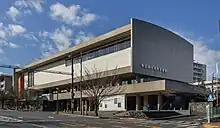National Museum of Modern Art, Tokyo
The Tokyo National Museum of Modern Art (東京国立近代美術館, Tōkyō Kokuritsu Kindai Bijutsukan) in Tokyo, Japan, is the foremost museum collecting and exhibiting modern Japanese art.[1]
Tōkyō Kokuritsu Kindai Bijutsukan | |
 Main Hall | |
| Established | 1952 |
|---|---|
| Location | Chiyoda, Tokyo, Japan |
| Coordinates | 35°41′26″N 139°45′17″E |
| Type | Art museum |
| Website | www |
This Tokyo museum is also known by the English acronym MOMAT (National Museum of Modern Art, Tokyo). The museum is known for its collection of 20th-century art and includes Western-style and Nihonga artists.
History
The National Museum of Modern Art, Tokyo, was the first national museum of art in Japan and dates back to 1952, when it was established as an institution governed by the Ministry of Education. The architect of the building was Kunio Maekawa. On two later occasions, neighbouring premises were purchased and the museum was further enlarged. The most recent redesign of MOMAT was conceived by Yoshirō Taniguchi (father of Yoshio Taniguchi who designed the extension of MOMA in New York City).
Collections
The collection contains many notable Japanese artists since the Meiji period, and a few contemporary Western prints.
In the early years of the 20th century, Matsukata Kojiro collected Japanese ukiyo-e woodblock prints which had been scattered throughout the world. The 1925 exhibition of the woodblock prints Matsukata collected abroad is thought to have been the first of its kind in Japan.[2] Today, around 8,000 ukiyo-e prints from the Matsukata collection are housed in the MOMAT.[3]
Crafts Gallery
In 1977, the museum opened an annex, the Kōgeikan Crafts Gallery, that collects and exhibits textiles, ceramics, lacquer, and other Japanese crafts, as well as crafts and designs from around the world dating from the late 19th century to the present. Its collection focus in particular is the work of Japanese Living National Treasures. The Crafts Gallery maintains its own research library.
In 2020, as part of the Japanese government's policy to revitalize local areas, the Crafts Gallery was relocated to Kanazawa and the National Crafts Museum was opened there. Even after the relocation, the official name is still the National Museum of Modern Art, Tokyo Craft Gallery.
National Film Center
Until April 2018, the National Museum of Modern Art housed the National Film Center (NFC), which was Japan's only public institution devoted to cinema. In April 2018, the NFC became independent of the art museum and was officially elevated to the rank of a national museum under the name the National Film Archive of Japan.[4]
Union catalog
The "Union Catalog of the Collections of the National Art Museums, Japan" is a consolidated catalog of material held by the four Japanese national art museums—the National Museum of Modern Art in Kyoto (MOMAK), the National Museum of Modern Art in Tokyo (MOMAT), the National Museum of Art in Osaka (NMAO), and the National Museum of Western Art in Tokyo (NMWA):[5]
The online version of this union catalog is currently under construction, with only selected works available at this time.[5]
References
- Nussbaum, Louis-Frédéric. (2005). "Museums" in Japan Encyclopedia, pp. 671-673.
- Checkland, Olive. (2002). Japan and Britain After 1859: Creating Cultural Bridges, p. 107.
- NMWA collection
- "6館目の国立美術館 国立映画アーカイブがきょう誕生". 東京新聞 TOKYO Web (in Japanese). Retrieved 13 April 2018.
- IAI-National Museums of Art union catalog
See also
References
- Checkland, Olive. (2002). Japan and Britain After 1859: Creating Cultural Bridges. London: Routledge. ISBN 0-7007-1747-1
- Falk, Ray. "French Art in Tokyo," New York Times. June 21, 1959.
External links
- da Silva, Joaquín (29 April 2016). "Chronology of Japanese Cinema: 1900". EigaNove.
- National Museum of Modern Art, Tokyo (in English)
- Artfacts.net: MOMAT overview
- Independent Administrative Institution National Museum of Art (in Japanese)
- Show of Leiko Ikemura in the National Museum of Modern Art, Tokyo 2012
